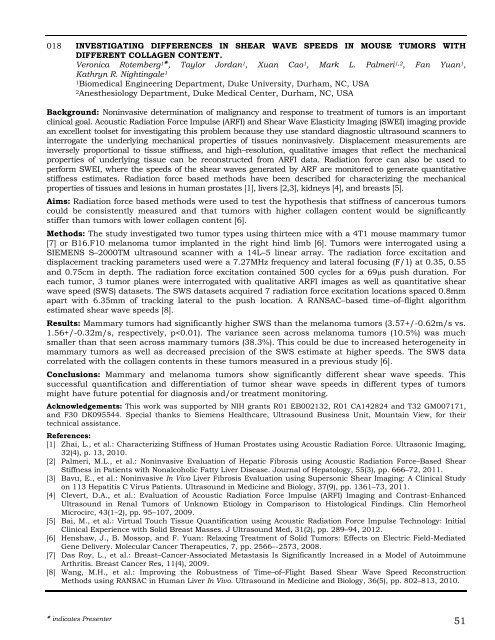2012 Proceedings - International Tissue Elasticity Conference
2012 Proceedings - International Tissue Elasticity Conference
2012 Proceedings - International Tissue Elasticity Conference
Create successful ePaper yourself
Turn your PDF publications into a flip-book with our unique Google optimized e-Paper software.
018 INVESTIGATING DIFFERENCES IN SHEAR WAVE SPEEDS IN MOUSE TUMORS WITH<br />
DIFFERENT COLLAGEN CONTENT.<br />
Veronica Rotemberg 1 , Taylor Jordan 1 , Xuan Cao 1 , Mark L. Palmeri 1,2 , Fan Yuan 1 ,<br />
Kathryn R. Nightingale 1<br />
1 Biomedical Engineering Department, Duke University, Durham, NC, USA<br />
2 Anesthesiology Department, Duke Medical Center, Durham, NC, USA<br />
Background: Noninvasive determination of malignancy and response to treatment of tumors is an important<br />
clinical goal. Acoustic Radiation Force Impulse (ARFI) and Shear Wave <strong>Elasticity</strong> Imaging (SWEI) imaging provide<br />
an excellent toolset for investigating this problem because they use standard diagnostic ultrasound scanners to<br />
interrogate the underlying mechanical properties of tissues noninvasively. Displacement measurements are<br />
inversely proportional to tissue stiffness, and high–resolution, qualitative images that reflect the mechanical<br />
properties of underlying tissue can be reconstructed from ARFI data. Radiation force can also be used to<br />
perform SWEI, where the speeds of the shear waves generated by ARF are monitored to generate quantitative<br />
stiffness estimates. Radiation force based methods have been described for characterizing the mechanical<br />
properties of tissues and lesions in human prostates [1], livers [2,3], kidneys [4], and breasts [5].<br />
Aims: Radiation force based methods were used to test the hypothesis that stiffness of cancerous tumors<br />
could be consistently measured and that tumors with higher collagen content would be significantly<br />
stiffer than tumors with lower collagen content [6].<br />
Methods: The study investigated two tumor types using thirteen mice with a 4T1 mouse mammary tumor<br />
[7] or B16.F10 melanoma tumor implanted in the right hind limb [6]. Tumors were interrogated using a<br />
SIEMENS S–2000TM ultrasound scanner with a 14L–5 linear array. The radiation force excitation and<br />
displacement tracking parameters used were a 7.27MHz frequency and lateral focusing (F/1) at 0.35, 0.55<br />
and 0.75cm in depth. The radiation force excitation contained 500 cycles for a 69µs push duration. For<br />
each tumor, 3 tumor planes were interrogated with qualitative ARFI images as well as quantitative shear<br />
wave speed (SWS) datasets. The SWS datasets acquired 7 radiation force excitation locations spaced 0.8mm<br />
apart with 6.35mm of tracking lateral to the push location. A RANSAC–based time–of–flight algorithm<br />
estimated shear wave speeds [8].<br />
Results: Mammary tumors had significantly higher SWS than the melanoma tumors (3.57+/-0.62m/s vs.<br />
1.56+/-0.32m/s, respectively, p









